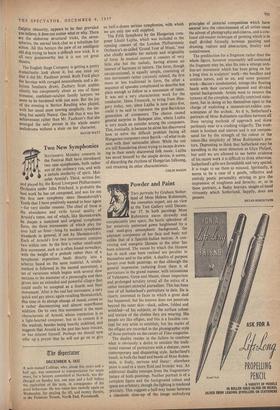Two New Symphonies
SUCCESSIVE Monday concerts in the Festival Hall have introduced two new symphonies, both rather out of the ordinary run, and with a certain similarity of spirit. Mal- colm Arnold's Third, written for, and played by, the Royal Liverpool Philharmonic Orchestra under John Pritchard, is probably the best work he has yet composed, and was for me the first new symphony since Shostakovich's Tenth that I have positively wanted to hear again —for very similar reasons. The chief of these is the abundance and virile lyrical quality of Arnold's tunes, out of which, like Shostakovich, he shapes a sustained and original symphonic form, the three movements of which play for over half an hour—long by modern symphonic standards in general, if not by Shostakovich's. Each of Arnold's first two movements contains two within one. In the first a rather small-scale first movement, such as is often found nowadays, with the weight of a prelude rather than of a symphonic exposition, leads directly into a scherzo based on the same material. A similar method is followed in the second movement, a set of variations which begins with several slow sections in the mannner of a passacaglia and then grows into an extended and powerful allegro that could easily be accepted as a fourth and final movement. After it the real last movement, a very quick and gay piece, again recalling Shostakovich, this time in its abrupt change of mood, comes as a rather disconcerting and almost superfluous addition. On its own this movement is the most characteristic of Arnold, whose reputation is as a light-hearted composer, but in its context it is the weakest, besides being heavily indebted, and suggests that Arnold in the past has been miscast, or has miscast himself. Perhaps we should now offer up a prayer that he will not go on to give
us half-a-dozen serious symphonies, with which we are only too well supplied.
The Fifth Symphony by the Hungarian com- poser Laszlo Lajtha, which was included in the opening concert of the London Philharmonic Orchestra's so-called 'Grand Tour of Music,' was also chiefly notable for melody and originality of form. In musical content it consists of very little else but the melody, having almost no interest of harmony or texture. The form, though unconventional, is equally simple, consisting of two movements rather curiously related, the first more or less traditional in form, the other a sequence of episodes complicated to describe but plain enough to follow as a succession of tunes. It was not a very characteristic work for the conductor, Janos Ferencsik, to bring from Hun- gary today, nor, since Lajtha is now sixty-five, could it be said to represent the post-Bartokian generation of composers. The choice caused general surprise in Budapest also, where Lajtha is very much an outsider among the composers. This, ironically, is because he alone has discovered how to solve the difficult problem facing all Hungarian composers since BartOk—of what to do next with their nationalist idiom. While the rest are still floundering about trying to escape drown- ing in their newly discovered folk music, Lajtha has saved himself by the simple device, it seems, of discarding the rhythms of Hungarian folksong, and retaining its other characteristics.
COLIN MASON














































 Previous page
Previous page